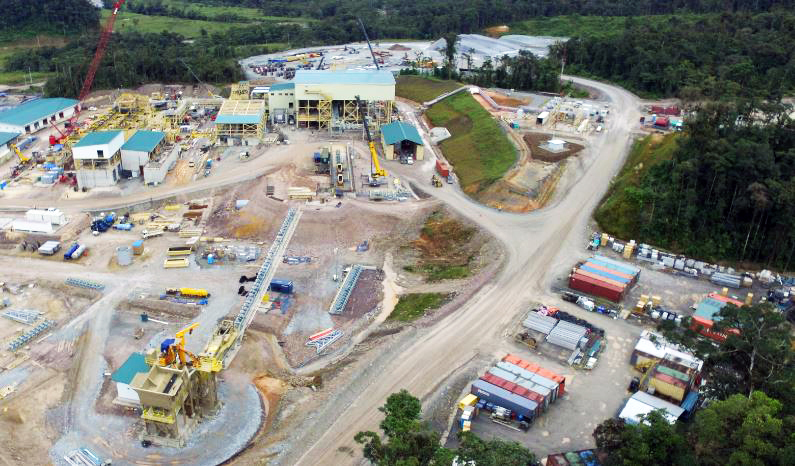Lundin Gold drills 46.98 g/t gold over 3.5 metres at Fruta del Norte, Ecuador

Lundin Gold Inc. [LUG-TSX, Nasdaq Stockholm; LUGDF-OTCQX] reported results from the near-mine and conversion drilling programs at its 100%-owned Fruta del Norte (FDN) gold mine in southeast Ecuador. The near-mine drill program discovered three new targets of interest, Fruta del Norte South (FDNS), Bonza Sur and Castillo, located to the south of FDN.
Highlights from near-mine exploration holes drilled (not true widths): Drill hole FDNS-2023-019 intersected 5.16 g/t gold over 41.8 metres from a depth of 397.3 metres, including 8.56 g/t gold over 18.0 metres from 421.3 metres (at FDNS).
Drill hole BLP-2022-016 intersected 8.27 g/t gold over 39.0 metres from a depth of 58 metres, including 277.0 g/t gold over 1.0 metre from 70.0 metres (at Bonza Sur).
Drill hole BLP-2023-022 intersected 46.98 g/t gold over 3.5 metres from a depth of 126.6 metres, including 87.58 g/t gold over 1.8 metres from 128.3 metres (at Bonza Sur).
Ron Hochstein, president and cCEO, commented: “I am pleased to announce exciting drill results from Lundin Gold’s near-mine drilling program. These results demonstrate the significant exploration potential of our land package that we have just started to test. The discovery of FDNS, which shows similar characteristics to FDN, and high-grade intercepts drilled at other targets of interest along trend are evidence of the potential significant gold mineralization in multiple targets surrounding the FDN deposit. Based on these results, we want to accelerate the delineation of these new exploration opportunities and are therefore planning to increase our near-mine drilling program for 2023 from 15,500 to 23,000 metres while maintaining our regional exploration program at 12,500 metres.”
The near-mine exploration program focuses on exploring sectors located along trend of the FDN deposit and within extensions of its major controlling structures. Initial drill results published in January identified potential areas of interest.
Based on further drilling conducted at the start of 2023, these areas are better understood and have enabled the delineation of a new mineralized zone, FDNS, and the discovery of Bonza Sur and Castillo. Results are still pending for a number of the reported drill holes.
At FDN South, the drill program aims to delineate new buried epithermal mineralization located to the west of the East fault. Results from hole FDNS-2023-019 indicate there is significant potential to continue exploring along strike, to the north and south, as well as along the downdip continuity, below the Suarez basin cover.
Drilling to test a geochemical soil anomaly along the south extension of the East fault intercepted a new mineralized zone, Bonza Sur located 1 km south of FDN. Drill hole BLP-2022-016 intercepted high-grade gold mineralization hosted in a wide hydrothermal alteration zone. Additional drilling confirmed mineralization continues along strike to the south and at depth. The geochemical soil anomaly at Bonza Sur extends over 1.2 km.
At Castillo, the first drill hole completed, BLPW-2022-017, returned positive results. This target, located underneath the Suarez basin west of the East fault and south of FDNS, is in a similar geological setting to FDN and FDNS. This target area is planned to be further explored during 2023, where additional drilling will target wider mineralized zones at depth.
Along the West structure, underground exploration drill holes intercepted a mineralized zone west of the West fault.
The near-mine exploration drilling program results continue to demonstrate the significant untapped exploration potential near the current FDN deposit. Most of the near-mine drilling to date has intercepted wide and consistent hydrothermal alteration zones related to epithermal systems, and several early-stage discoveries, such as FDNS and Bonza Sur, have already been made. As a result of the recent advances and to accelerate delineation of these targets and continue to explore other sectors along FDN’s major structures, the company plans to increase the near-mine drilling program to a minimum of 23,000 metres in 2023, up from 15,500 metres originally planned. This will result in an estimated increase of $3.5-million which, combined with the regional program, results in an estimated program cost of $24.6-million on near-mine and regional exploration for the year.
The company’s conversion program aims to convert mineral resources to mineral reserves. The 2023 program, which entails approximately 7,600 metres of drilling, is under way. Highlights from the 2023 conversion program include (not true widths) drill hole FDN-C23-002 that intersected 10.18 g/t gold over 26.65 metres from 112.3 metres, including 19.41 g/t gold over 8.9 metres from 123.3 metres.
Drill hole FDN-C23-003 intersected 7.84 g/t gold over 45.6 metres from 101.2 metres, including 13.67 g/t gold over 5.8 metres from 107.4 metres; 12.67 g/t gold over 12.4 metres from 132.2 metres.
Drill hole FDN-C23-010 intersected 8.02 g/t gold over 24.6 metres from 27.0 metres, including 58.34 g/t over 2.7 metres, and 12.12 g/t gold over 40.9 metres from 81.6 metres.
Since January, a total of 1,706 metres across 10 drill holes have been completed with all initial results confirming the continuity, grades and width of the drilled areas beyond the FDN mineral reserve boundary. In the north-central sector of FDN, high-grade drilling intercepts from along the downdip extension of the deposit were returned. In the southern extension, all drill holes intercepted wide zones of hydrothermal alteration and confirmed the continuity of the deposit in this sector with significant assay results.
